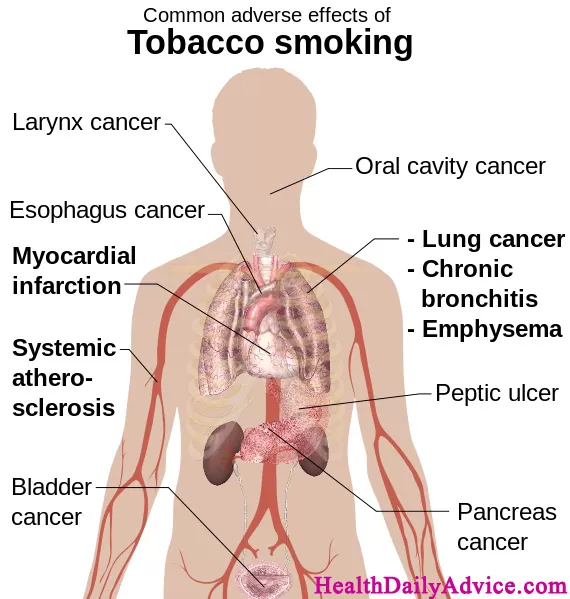Introduction:
In This Post, We Discuss Tobacco Dependence. There are over a billion people who smoke tobacco around the world, which makes it one of the most popular psychoactive substances, used in society. The majority of tobacco users smoke cigarettes, but some smoke cigars or pipes, chew tobacco, or practice snuffing which is where ground-up tobacco leaves are pushed up the nose. Given the popularity of tobacco as well as its negative health consequences, it’s considered one of the advanced causes of preventable death and disease worldwide. Cigarette smoke contains over 4,000 toxic chemicals.
Causes, Symptoms, Diagnosis, Treatment, Pathology:

Causes:
- These toxins cause endothelial cell damage which creates inflammation along the inner lining of arteries.
- The inflammation increases the risk of having a myocardial infarction – a heart attack, a stroke, and peripheral vascular disease which is where there is severe pain in the lower legs.
- The toxins can also cause pulmonary problems because the toxins get deposited into the lungs, which damages the lung tissue and make them more likely to get infected as well.
- Finally, cigarette smoke has a lot of different carcinogens, including ammonia, formaldehyde, and carbon monoxide, which are associated with cancers of the mouth, throat, lungs, bladder, pancreas, and uterus. Combining these effects, a heavy smoker who smokes two packs of cigarettes each day, for20 years, loses about 14 years of life.
- Despite the negative consequences of smoking, most people continue to smoke because tobacco contains nicotine, a tiny, fat-soluble molecule that creates pleasurable psychoactive effects and is extremely addictive. Nicotine is considered responsible for the high rates of tobacco dependence and addiction, while the 4,000 other chemicals and compounds are responsible for the negative health effects associated with smoking.
- When a cigarette is lit, some of the nicotine gets destroyed by the heat, and some gets into the smoke that gets inhaled. As a result, smokers can self-titrate their nicotine dose by inhaling more frequently, more deeply, or for a longer amount of time. Once nicotine is absorbed into the bloodstream, it binds to a type of acetylcholine receptor, called a nicotinic acetylcholine receptor – also called a nicotinic receptor – which is found throughout the body and brain.
Nicotine:
- In the central nervous system, nicotinic receptors are on pre-synaptic axon terminals of neurons, and when nicotine binds to them, it triggers the release of neurotransmitters like dopamine, acetylcholine, and glutamate, which is why it’s considered an acetylcholine agonist.
- The psychoactive effects of nicotine are related to the locations of nicotinic receptors in the brain and the specific neurotransmitters that are released when the receptors are stimulated. For example, increased dopamine in the mesolimbic system, a reward pathway composed of the ventral tegmentum and the nucleus accumbent causes pleasure, improved attention and mental processing, and working memory.
- Nicotine directly increases dopamine levels in the nucleus accumbent, but it also increases glutamate levels which gets the ventral tegmentum neurons to release more dopamine into the nucleus accumbens.
- Nicotine was also decreasing the activity of inhibitory GABA neurons in the ventral tegmentum, so by inhibiting the inhibitory neurons, there’s a double negative, which means that this is one more way to create an increase in dopamine levels. When nicotine binds to receptors in the peripheral nervous system, it increases blood pressure, heart rate, cardiac contractility, and gastrointestinal tract activity.
- Nicotine also binds to receptors in skeletal muscles causing relaxed muscle tone. Over time, individuals who consistently use cigarettes can develop tolerance to the effects of nicotine. This means that with returned use, they have a reduced response to nicotine, and therefore increased dose of nicotine is needed to achieve the original response.
- At a cellular level, there are a couple of theories that explain why this might happen. One is that repeated exposure to nicotine may cause nicotinic receptors to become less sensitive to nicotine.
- Another theory is that neurons may remove nicotinic receptors from the cell wall in a process called down-regulation, leaving fewer receptors available for binding. In either scenario, tolerance leads to the requirement for higher and higher doses of nicotine over time.
- Let’s step back for a moment – and say that you are at rest, without anything stimulating your reward pathway. In this situation, your brain holds your heart rate, blood pressure, and wakefulness in a natural state called homeostasis. Now, let’s say that your secret crush forwards you a text. All of a sudden you may appear sweaty and flushed; your heart rate may jump a bit. You are now above your normal level of homeostasis because something has changed, right? But it doesn’t stay that way for long, and after the text, your brain brings things back down to this baseline. With repeated cigarette/tobacco use, a few things start to happen.
- If you smoke at a specific time and setting, like on the porch at 6 pm after dinner, and being a stimulant, it makes everything speed up, including heart rate, blood pressure, and wakefulness. Your brain picks up on that pattern! Next time, when you are on the porch at 6 pm after dinner, your brain preemptively decreases the heart rate, blood pressure, and wakefulness to create balance, because it knows that when you smoke a cigarette, everything is going to increase. Now, let’s say that your 6 pm after-dinner porch time rolls around, but you don’t have a cigarette. In that situation, the brain still decreases heart rate and blood pressure, but the changes aren’t countered by the effects of nicotine, so you might feel awful.
Withdrawal Symptoms:
- These awful feelings are called withdrawal symptoms. Withdrawal symptoms can persist to the point where a person may need to smoke just to feel normal. Symptoms of nicotine withdrawal include severe craving for nicotine, irritability, anxiety, anger, poor concentration, restlessness, impatience, increased appetite, weight gain, and insomnia. Withdrawal symptoms can begin within 2 hours after the last use of tobacco and typically peak within 1 or 2 days. While withdrawal tends to decline over the next few days and weeks, many smokers continue to feel awful for months after their last cigarette.
- The withdrawal symptoms associated with stopping smoking and the intense feelings of craving make it very difficult to stop smoking – in fact, nearly 70% of those who smoke say that they want to quit, and more than half of smokers try to quit each year, but of those, only about 5% are successful. The liver is quick to metabolize and eliminate nicotine from the body; in fact, its half-life is only about 1-2 hours.
- To maintain the positive feelings that nicotine creates and avoid withdrawal, a person has to smoke a cigarette every 2 hours or so, to reach a steady state of nicotine in the blood – and that helps explain why individuals become chain smokers. Also, at night, the liver eliminates the nicotine that has built up throughout the day, which is why heavy smokers often need a cigarette first thing in the morning.

Treatment:
- There are several different smoking cessation treatments.
- Nicotine replacement therapies include nicotine-containing gum, lozenges, transdermal patches, nasal sprays, inhalers, dissolvable tobacco, mouth sprays, and sublingual products. These products are meant to help a person slowly taper their dose of nicotine and ultimately quit altogether.
- Some medications act on nicotinic receptors like bupropion and partial nicotine receptor agonists like varenicline which help reduce withdrawal symptoms and prevent relapse. Both of these can be used in conjunction with nicotine replacement medications and have been shown to increase the success rates of individuals trying to quit tobacco.
- Some smokers turn to electronic cigarettes, which are battery-powered devices that produce a nicotine vapor that is inhaled. Like some of the other nicotine replacement medications, they allow smokers to go outside, enjoy the feeling of holding a cigarette, and inhale and exhale a vapor. Electronic cigarettes offer the same theoretical advantages of nicotine replacement, but unlike nicotine replacement medications there is less research on the safety of e-cigarettes.
- People trying to quit can also benefit from simple therapy interventions, for example, simply asking a person about their willingness to quit, actually increases the likelihood that they will quit. Typically at clinic visits, it’s recommended to ask about tobacco use, advice to quit or cut back, assess whether a person is willing to quit, assist with quit attempts by offering counseling and medications, and help arrange or organize a support network.
- All right, as a quick recap, the nicotine in tobacco affects different neurotransmitters and neural systems in the brain, which produces effects that are initially pleasant but can become more problematic and unpleasant if smoking continues over time.
- Long-term use can cause tolerance, which is the need for increasing doses to achieve the same effect, as well as dependence, which is reliance on tobacco/nicotine to function normally.
- The most effective treatments can involve a combination of therapy and medication with a lot of love and support from family and friends.
FAQs
Tobacco Dependence, often referred to as nicotine addiction, is caused by the addictive nature of nicotine found in tobacco products. Nicotine stimulates the release of dopamine in the brain, creating a reinforcing pattern of use.
Symptoms include an inability to quit or cut down on tobacco use, cravings for nicotine, withdrawal symptoms (irritability, anxiety, difficulty concentrating) when attempting to quit, and continuing tobacco use despite knowing its harmful effects.
Diagnosis is often based on a thorough assessment of the individual’s tobacco use history, dependence level, and the presence of withdrawal symptoms when attempting to quit. Healthcare professionals may use standardized questionnaires to aid in diagnosis.
Treatment options include behavioral interventions, counseling, and pharmacotherapy. Nicotine replacement therapies (patches, gum, lozenges), prescription medications (such as bupropion and varenicline), and support groups are commonly used to help individuals quit smoking.
Tobacco Dependence is a major risk factor for various health issues, including cardiovascular diseases, respiratory diseases, and various cancers. It also contributes to reduced overall life expectancy and quality of life.
Note:
So in This Post, Tobacco Dependence What other points can you think of/have experienced? Let me know in the comments.
If you found this helpful or feel free to share your experience if you can relate to these points and if you are comfortable share
For More Articles Related to Tobacco Dependence Stay Tuned To our Site: Health Daily Advice













